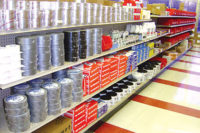Heating, Air-conditioning, and Refrigeration Distributors International (HARDI) recently presented its “HARDI Unitary HVAC Market Share Report,” providing market share data and analysis detailing unitary sales based on product efficiency for both ducted and ductless cooling equipment, as well as furnaces and boilers. The report is designed to provide industry members with a simple and effective method for tracking the HVACR equipment market.
The survey revealed numerous substantial findings including that the majority of the industry prefers R-410A, that units boasting SEER 13 efficiency and those ranging in 80-84 percent AFUE equipment were the most heavily distributed, and that R-22 was more likely to be sold in ducted air conditioners than ductless equipment.
Refrigerant Choices
The report revealed that when given a choice, national HVACR ducted equipment and refrigerant purchasers preferred R-410A, as only approximately 11 percent of those surveyed selected R-22 in the same equipment. However, for ductless equipment, the national rate showed a 100 percent choice of R-410A. The numbers looked much the same for overall and ducted a/c measurements, showing that just under 14 percent chose R-22, with the rest selecting R-410A. The ductless a/c story followed the aforementioned ductless trend as 100 percent of respondents chose R-410A.
SEER Data
Regarding unitary equipment, 13-13.99 SEER is the most distributed efficiency rate nationally. The same holds true when examining the distributed efficiency rate results for ducted unitary equipment. The most commonly distributed SEER rating for ductless-only equipment, however, range from 18-18.99 with 20-22.99 coming in a close second.
When looking specifically at the SEER rating for all unitary and ducted a/c shipments, the most popular SEER rating for both is 13-13.99. For ductless air conditioners, however, more 19-19.99 SEER units were shipped than 15-15.99. The same 13-13.99 SEER shipment popularity remains true for all unitary and ducted heat pumps as well.
Ductless unitary heat pump shipments show that 18-18.99 SEER units were most popular in the second quarter, with 20-20.99 coming in second, and 16-16.99 in third.
AFUE and Fuel Statistics
Most heating equipment distributed registered at 80-84.99 AFUE. Approximately 30 percent of equipment registered in at 95-plus AFUE. Together, these categories totaled just under 90 percent of the second-quarter shipments, leaving the last 10-12 percent of shipments divided amongst the remainder of the five listed AFUE options.
The majority of furnace shipments ranged in the 80-84.99 equipment category nationally. The Great Lakes and Northeastern regions rated the 95-plus AFUE furnaces as the most popular. When examining fuel type equipment shipments, natural gas ranked No. 1 by region, as well as in the furnace category. Second place went to electric equipment and oil units ranked third.
Participation Growth
The study and its results were overseen by Toby Swope, manager of data analysis, D&R Intl., and Brian Loftus, market research and benchmarking analysis, HARDI. Swope and Loftus mentioned that participants did not receive financial compensation in exchange for their participation, but they do receive a copy of the quarterly report along with a detailed analysis of their own unitary results.
“Participation is voluntary and the level varies from region to region,” said Swope. “However, the depth of data is growing and we are always working with the participants to identify more effective ways to evaluate the market and present what we find.”
The third-quarter report is due out later this year.
HVAC Outlook Study
HARDI’s fifth annual “Mid-Season HVAC Distributor Survey” is another mid-year study that offers in-depth distribution data to the HVACR industry. Conducted in partnership with JP Morgan Equity Research, the study noted that “The normalization of the HVAC market is happening, with demand and consumer behavior approaching something closer to a medium-term trend line. Inventories are falling more in line with demand, while pricing is becoming incrementally harder to come by.”
C. Stephen Tusa, JP Morgan’s HVAC industry analyst, noted that a hint of optimism seems to be rubbing off on HARDI distributors as more than half of the project’s respondents noted that they expect their short-term revenues to improve by 5-10 percent.
“For the first time in our survey, more distributors expected repair activity to decline. That could be an indication of an unlocking of the pent-up demand from units that were fixed instead of replaced over the past few years,” said Tusa. “Sales of condensing units and furnaces have been better than expected and SEER mix has also improved. There have been more system replacements and consumers are opting for more expensive systems.”
Tusa noted that some of this optimism could be explained by a slightly improved housing and construction market outlook. According to him, it took almost five years from the first-quarter 2006 peak for the market to find a bottom.
“Confidence in a recovery was improving in the back half of 2012,” he said. “The 2013 forecast had a positive bias because the correction had been so deep and painful. At the time it was difficult to generate a great deal of confidence in an aggressive growth forecast, but that would have been more accurate.”
Other key items in the survey explored inventory and pricing, the commercial market, and information on residential-repair/replace dynamics. Inventory and pricing is something that the survey noted was changing.
“Inventories are no longer lean and pricing is getting tougher,” stated the report. “Neither pricing nor inventories are make-or-break issues for near-term earnings, but both are incrementally negative and remain areas to watch.”
According to the report, the commercial sector is expected to remain steady without any upward inflection, stating, “There were no major surprises in the commercial responses, with the tone slightly better but still pointing to average growth that struggles to move beyond the low-mid, single-digit range.”
This note was tempered with the fact that the survey focuses on unitary equipment sold through distribution and not the larger applied systems.
As for the residential demand environment, the survey reported that roughly 70 percent of respondents saw increases in sales versus 30 percent seeing declines in the second quarter. The responses revealed incremental progress in repair-replace dynamics matched the more upbeat assessment of the economy.
“The high single-digit growth we forecast in 2014 reflects a modestly higher replacement rate. If the economy continues to improve, we can expect another couple points from housing completions,” said Tusa. “Replacement rates are the wild card. They could easily turn down, but the industry boasts some momentum at this point.”
The full report and accompanying webinar is now available for member and non-member purchase on HARDI’s website. For more information, visit www.hardinet.org.
Publication date: 12/2/2013
Want more HVAC industry news and information? Join The NEWS on Facebook, Twitter, and LinkedIn today!










